Solar Moth
Racial Magic
First Ability
☀️Rithaldis' Charge
Can absorb and store up radiant energy inside their bodies without limit and cannot be harmed by radiant energy. They can convert this into magic energy, use it to strengthen their body or re-release it like an aura at will. As an aura, they can generate or summon radiant energy including radiation. However, unlike other manifestations, they cannot produce their own radiant energy. They are reliant on a source.
There are many kinds of solar moth or Shamsi Moth calling the Shamsi Desert home, something which might surprise outsiders. Most are a breed of hawk-moth. Some of these include the Bahija, Pallidus, Ssm Ifrawn, Ijjn or Bee Robber and the Nerium Solar Moths. The term solar moth may seem counter intuitive—moths are nocturnal aren't they? Shamsi is a unique biome when it comes to day and night cycles, this desert never fully dark. Miniature suns summoned by Khepri Scarab litter this sea of sand, a critical resource to these tiny invertebrates.
Understanding the need for these insects as pollinators and food sources, Lithmor blessed these little creatures with radiant magic so they could adapt to her alterations to the land. She also found many of them surprisingly beautiful, a unique blending of her owm element and that of her husband's. Every kind of solar moth has one quality in common: they all possess Rithaldis' Charge! They can be seen visiting not only flowers in the continuous dusk of Shamsi but they also congregate around miniature suns hovering about the desert, drawing energy or even sustenance from them.
Many of these moths are also known to undertake considerable migrations. While all of these moths have Rithaldis' Charge, many will migrate to the Tenebrous Chain to feed and breed. Some will make their way back to Shamsi before laying their eggs while the rest do so in the caliginous mountains of Eluziar. According to legend, their journey between these polar opposite habitats has its roots in the romance between Lithmor and Zalikar! Myth claims that even when these two couldn't be at each others' side, these dazzling yet cryptic insects carried their love to each other.
Variations
Bahija
Can generate emotions or states related to Mpertem in those around them including joy, pride, bliss, mania, happiness, motivation, satisfaction or general euphoria. They use this to motivate each other on their long migrations and counteract effects of predators with dark magic in the Chain.
Deilephila elpenor
Elephant Hawk-Moth
Tenebrous Chain, Eluzian Valley, Sesli Plato, Flumen Pontem and Shamsi Desert. Prefer rough grasslands, heathland, sand dunes, hedgerows, woodland, urban gardens and open countryside.
Wingspan: 2.4-2.8 in (60-70 mm)
They can hover or fly up to 5 m/s
Caterpillars grow to 3 in (76 mm)
Mainly golden-olive with bright pink bars on the wings and body. In their magic form, the olive patterns turn searing white.
Adults eat nectar from honeysuckle and other tube flowers in the Tenebrous Chain and will absorb radiant energy from miniature suns when in Shamsi. Caterpillars eat leaves of willowherb, bedstraw, fuschia, nightshade, dahlia and lavender.
Pallidus
Able to allow their body to interact with physical matter similarly to shadows, most matter passing right through them when activated. Mainly used to confuse and evade predators in the night.
Acontia lucida
Pale Shoulder Moth
Eluzian Valley (especially in the western and southern valley), Tenebrous Chain, Flumen Pontem, Sesli Plato, Shamsi Desert and Arya. Prefers grassland, dry meadows, coastlands, steppes, dunes and roadsides.
Wingspan 1-1.2 in (26-30 mm)
Head, thorax and abdomen are white while it's body is covered in dark brown marbling and mottling. This brown turns charcoal gray in their magic form.
Caterpillars feed mainly on mallow, marshmallow, bindweed and dandelion. Adults eat nectar of marigold and woodland sage.
They are attracted to light and even possess echocation. Adults fly from May to August in two separate generations. They overwinter as pupa underground in Shamsi Desert, migrating into Eluziar or Arya as adults to feed.
Ssm Ifrawn
Able to secrete layers of photons so intense, it superheats the surrounding gases into plasma, lacing this ability into the scales of their wings. Their wings not only burn at the touch but are incredibly radioactive, imparting radiation poisoning to the unwary predator. However, they are dazzlingly beautiful!
Laothoe populi
Poplar Hawk-Moth
Primarily in the mountauns of the Shamsi Desert adjacent to Sesli Plato and along its northern coastlines but they can also be found throughout Eluziar, especially the Tenebrous Chain. They make their home amid tree lined streams, oases and rivers, preferring poplar and willow most. Adults can only live in the Shamsi Desert.
Wingspan: 3.8-4.7 in (95-120 mm)
Caterpillar: 2.8 in (70 mm)
Caterpillars are yellow-green with yellow stripes and tail horn and small red or white dots. Adults are striking, their fore wings and hind swings detached from each other. They resemble leaves with areas of grey and brown, until they reveal purplish false eyes when threatened. It's whole body becomes white in its magic form and it's wings sear, coated in radioactive plasma.
Two generations emerge a year, caterpillars feeding on the leaves of willow, apple, sallow, poplar and aspen. Adults take flight from July to August, breeding and laying their eggs in Eluziar or in wadis of Shamsi before spending the rest of their lives feeding on radiant energy of the desert. They are unable to sustain themselves in any other way after metamorphosis.
Ijjin/Bee Robber
Able to consume or absorb void as sustenance, to heal or to replenish magic energy. They cannot be harmed by void, natural or magical, absorbing it instead.
Acherontia atropos
African Death's Head Hawk-Moth
Present throughout Alkelbulan and Eluziar, breeding in the Shamsi Desert and migrating south or into the Eluzian Valley through the Flumen Pontem and Sesli Plato. They especially prefer the Tenebrous Chain.
Wingspan 3.1-5.5 in (80-140 mm)
Caterpillars are 5 in (125 mm)
Caterpillar can be yellow, green to brown. Adults are large and striking, carrying a distinct skull shaped pattern on the back of their thorax. Most of its coloration are dark brown and bright yellow, it's abdomen striped similarly to a hornet. It's forewints are all dark, contrasting the bright yellow hind wings. In their magic form, the dark brown goes stark black like an empty void and the yellow sears white and hot like plasma.
Nerium
Able to sense various flowers, herbs and fruit around them despite barriers and can identify them. Used to find their preferred flowers.
Daphnis nerii
Oleander Hawk Moth
Shamsi Desert and Xishi Shamo are the ideal home for their larva but the adults may migrate into Zhongguo or Bharat and even into Flumen Pontem and Eluzian Valley. They prefer scrublands and hillsides.
Wingspan is 3.5-5 in (9-13 cm)
Caterpillars are 2.2-3 in (5.5-7.5 cm)
Second Ability
 Mpertem's Aura
Mpertem's Aura
Can generate emotions or states related to Mpertem in those around them including joy, pride, bliss, mania, happiness, motivation, satisfaction or general euphoria. They use this to motivate each other on their long migrations and counteract effects of predators with dark magic in the Chain.
Original Ancestor
Elephant Hawk-Moth
Habitat
Size
They can hover or fly up to 5 m/s
Caterpillars grow to 3 in (76 mm)
Coloration
Diet
Adaptions
Bahija shamsi moths are capable of hovering like hummingbirds, a costly but useful adaption for feeding on nectar. They have also developed excellent night vision for identifying flowers in darkness, one of the few animals able to see color in the dark without magic! They mainly perceive blue, green and ultraviolet and can also find food by smell. Finally, they have false eyes both as caterpillars and on their wings as adults, used to frighten predators. They will spread these out when threatened to make them more visible. These also glow searing white in their magic form.
Life Cycle
One generation is born per year, larvae pupating underground over the winter in the Tenebrous Chain. Adults fly to Shamsi in June, absorbing radiant energy and breeding in the warmer environment before using this energy for their return to Eluziar in September. They live only long enough to lay their green eggs on the underside of food plants, hatching in 10 days. Caterpillars eat 11-30 g in plant matter before pupating. This species of Shamsi Moth heavily carries the metaphor and mythos of Lithmor sending her love to Zalikar and him accepting and fostering that love as he safeguards the pupa over the winter. The arrival of Bahija moths are an event locals in the Chain look forward to, their brilliant and colorful appearance bringing light and joy every year!
Pallidus
Second Ability
 Azowyr's Slip
Azowyr's Slip
Able to allow their body to interact with physical matter similarly to shadows, most matter passing right through them when activated. Mainly used to confuse and evade predators in the night.
Original Ancestor
Pale Shoulder Moth
Habitat
Size
Coloration
Diet
Life Cycle
Ssm Ifrawn
Racial Magic
☀️Rithaldis' Skin☀️
Able to secrete layers of photons so intense, it superheats the surrounding gases into plasma, lacing this ability into the scales of their wings. Their wings not only burn at the touch but are incredibly radioactive, imparting radiation poisoning to the unwary predator. However, they are dazzlingly beautiful!
Original ancestor
Poplar Hawk-Moth
Habitat
Size
Wingspan: 3.8-4.7 in (95-120 mm)
Caterpillar: 2.8 in (70 mm)
Coloration
Life Cycle
Ijjin/Bee Robber
Second Ability
⚫Vokda's Diet⚫
Able to consume or absorb void as sustenance, to heal or to replenish magic energy. They cannot be harmed by void, natural or magical, absorbing it instead.
Original Ancestor
African Death's Head Hawk-Moth
Habitat
Size
Caterpillars are 5 in (125 mm)
Coloration
Diet
Adults eat honey, especially that of Void Bees, sneaking into their hives. Their ancestors imitated the cutaneous fatty acids of the bees to fool them but these moths have no need, immune to their void magic and capable of destroying their entire hive with their radiant magic—the bees allow them to eat their fill of honey rather than risking its wrath. Caterpillars feed on the leaves of potato, verbena, Azeradj Olive Tree, beets, Nerium Cupidinis and butterfly bush.
Life Cycle
While capable of breeding throughout their range, including in Eluziar, they only breed continuously in the Shamsi Desert, pupating below ground in cooler climates until summer. Adults of the desert usually migrate south or east in search of honey. Caterpillars are fully grown in four weeks or sooner if they have access to the miniature suns in Shamsi. They are fairly sedentary as caterpillars, rarely leaving their feed plants. However, they aren't complacent, clicking their mandibles at threats and even biting them! They pupate for 4-6 weeks, digging 5-10 cm deep earthen shelters. After emerging, they absorb radiant energy within Shamsi before making the long journey east or south.
Mythology
Thanks to their ominous appearance and their dark magic, these moths are associated with death and doom. Some call them "Azryth's Messengers", believing they carry the souls of the dead to their master or carry messages between he and Zalikar. They are capable of making rapid squeaking sounds to alarm predators and give aggressors a single warning before unleashing their magic. This sound is considered an omen of impending death!
Nerium
Second Ability
 Lithyr's Sense
Lithyr's Sense
Able to sense various flowers, herbs and fruit around them despite barriers and can identify them. Used to find their preferred flowers.
Original Ancestor
Daphnis nerii
Oleander Hawk Moth
Habitat
Shamsi Desert and Xishi Shamo are the ideal home for their larva but the adults may migrate into Zhongguo or Bharat and even into Flumen Pontem and Eluzian Valley. They prefer scrublands and hillsides.
Size
Wingspan is 3.5-5 in (9-13 cm)
Caterpillars are 2.2-3 in (5.5-7.5 cm)
Coloration
Adults have alternating patterns of dark and light green with some gray markings. Caterpillars start out bright yellow with a black "horn" on their rear, slowly growing green to brown. They also developed a large blue and white false eye and their horn turns yellow.
Diet
Adults feed on the nectar of many flowers, their favorites being petunia, jasmine and honeysuckle, feeding after sunset. Caterpillar prefer feeding on Nerium Cupidinis but might also feed on dogbane or periwinkle.
Life Cycle
Caterpillars hatch and feed on nerium and when they are ready to pupate they will try to make their nest inside the soil, directly on the ground, under moss or in dead leaves. They pupate for 2-3 days and adults live 2-3 weeks, usually migrating into Eluziar or Zhongguo. They make this flight between August and October.

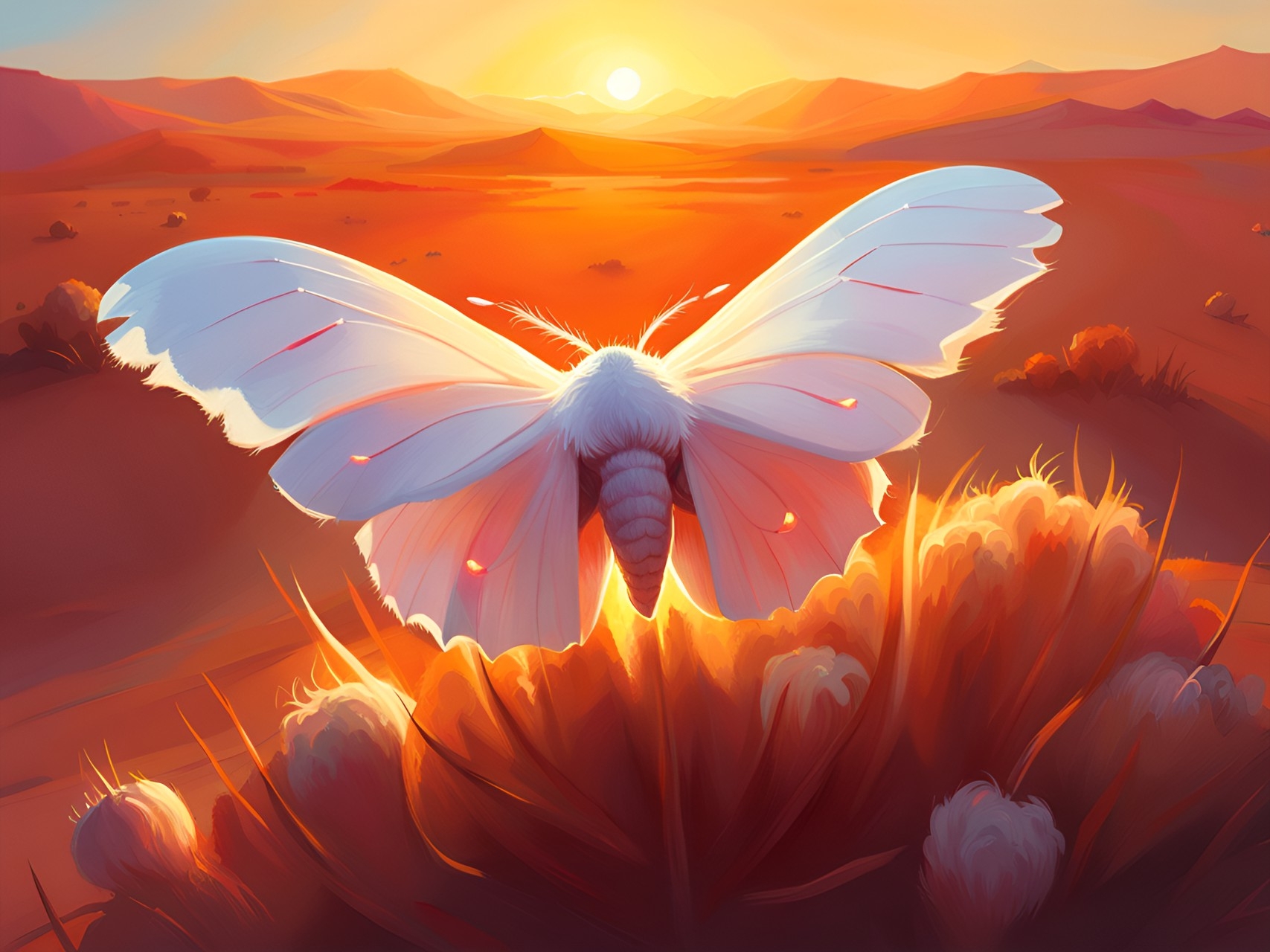
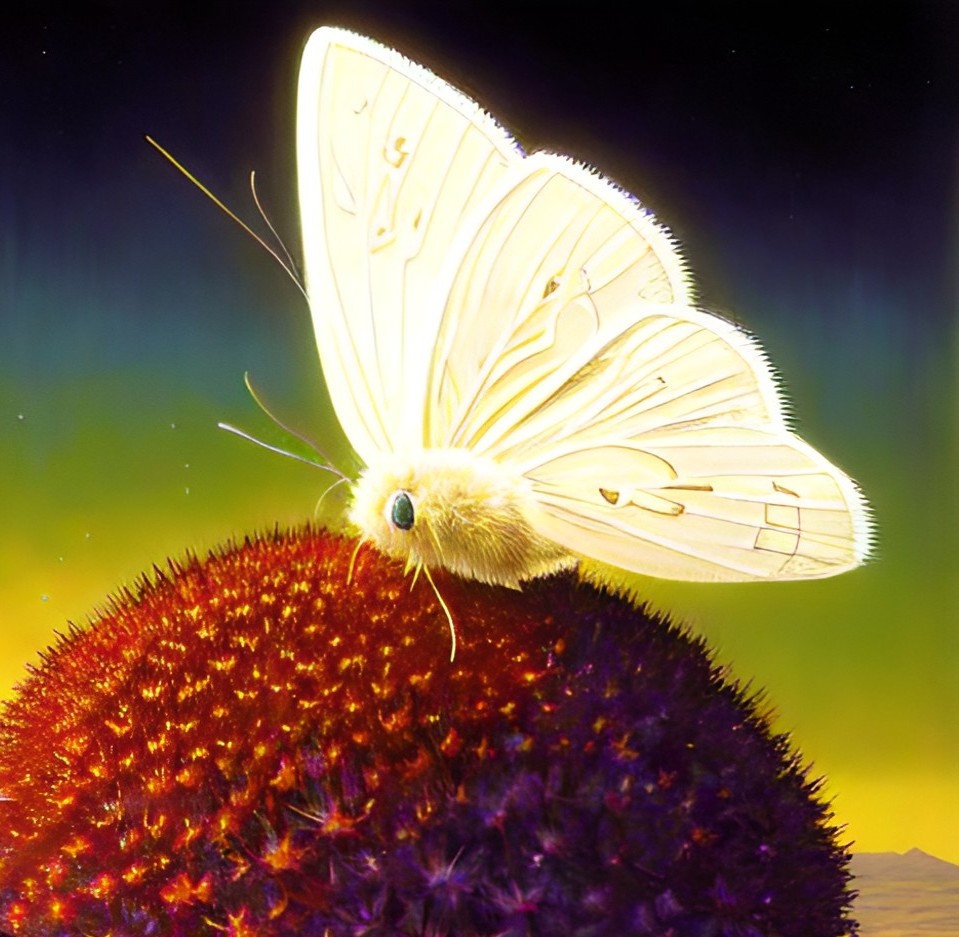
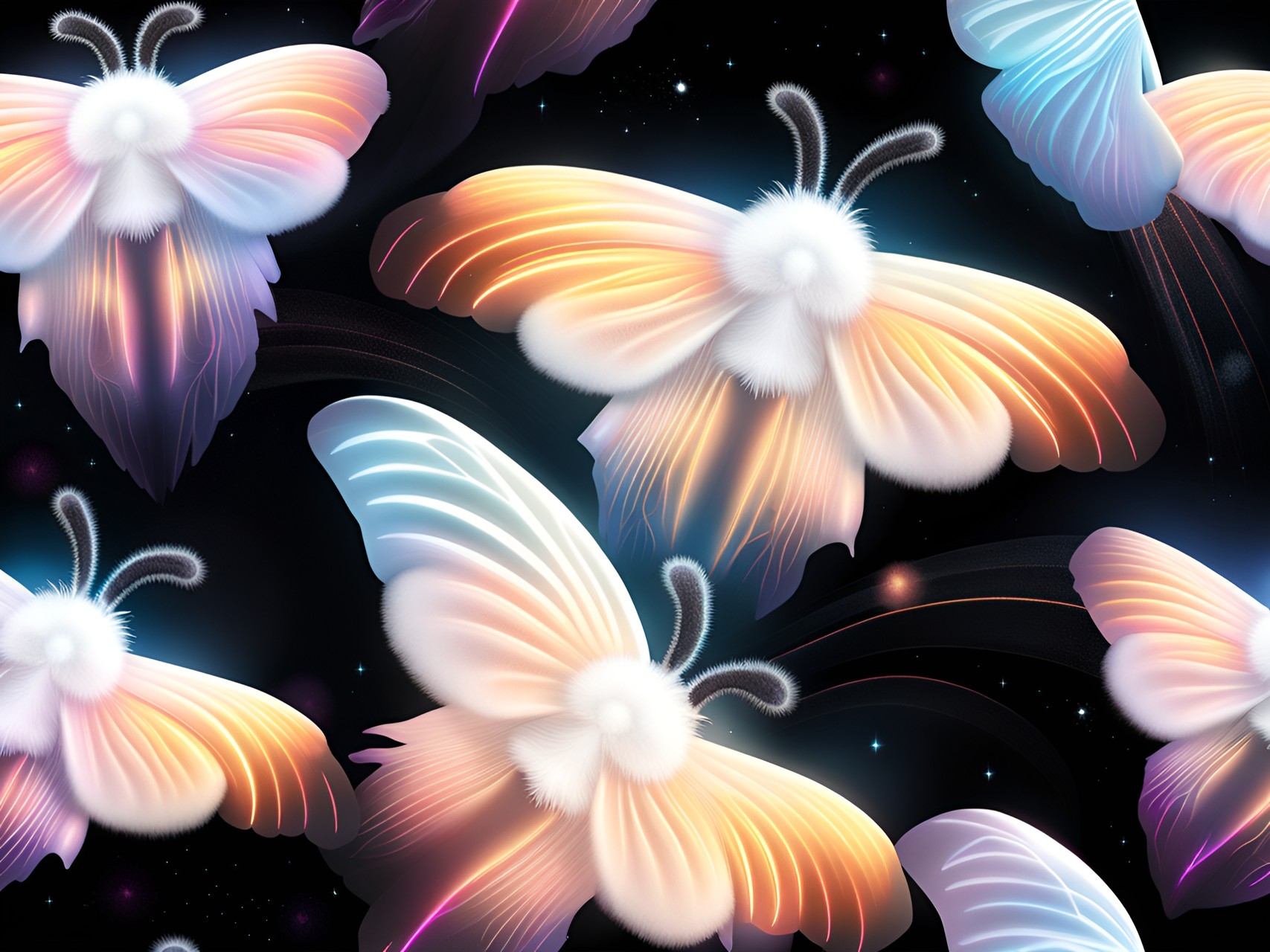
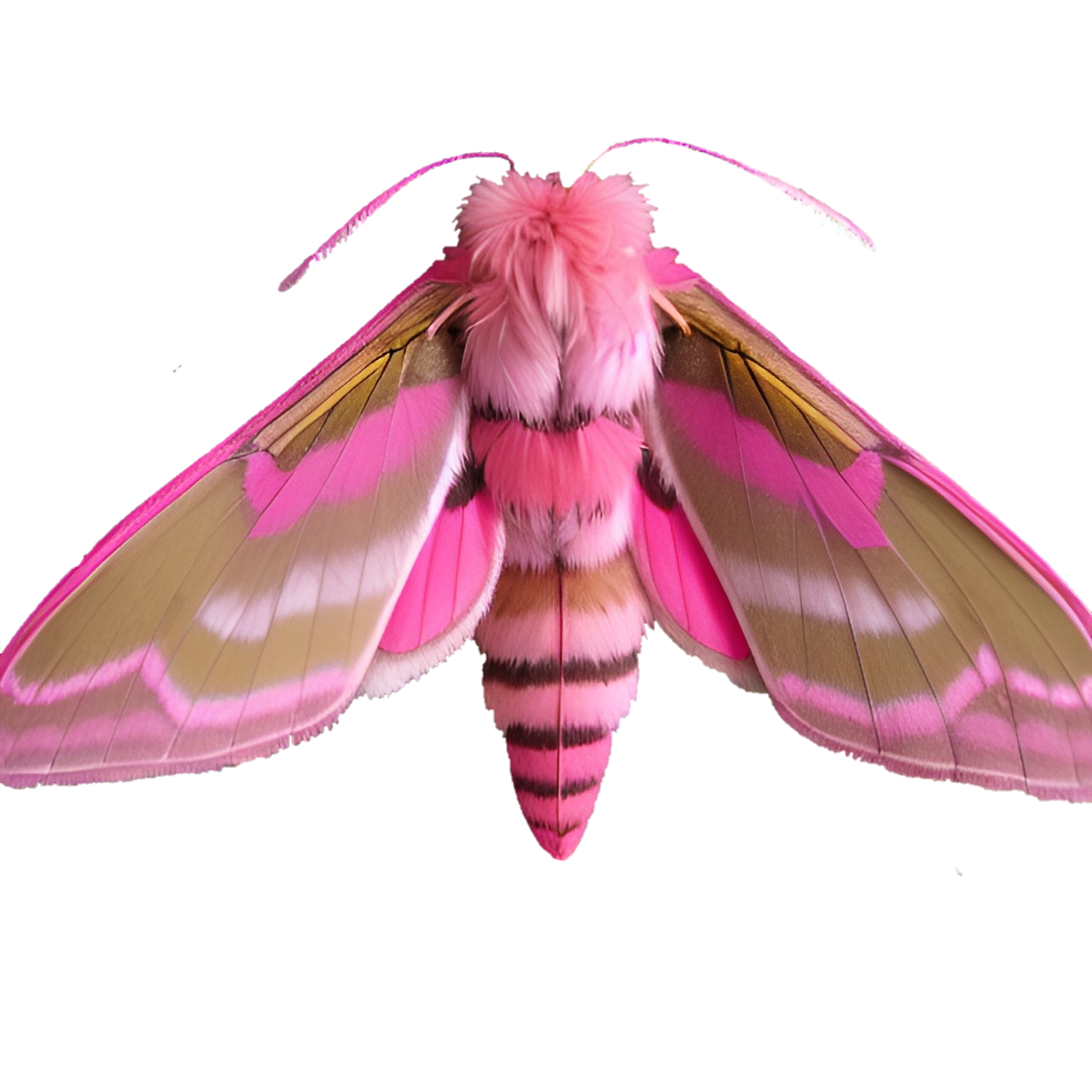
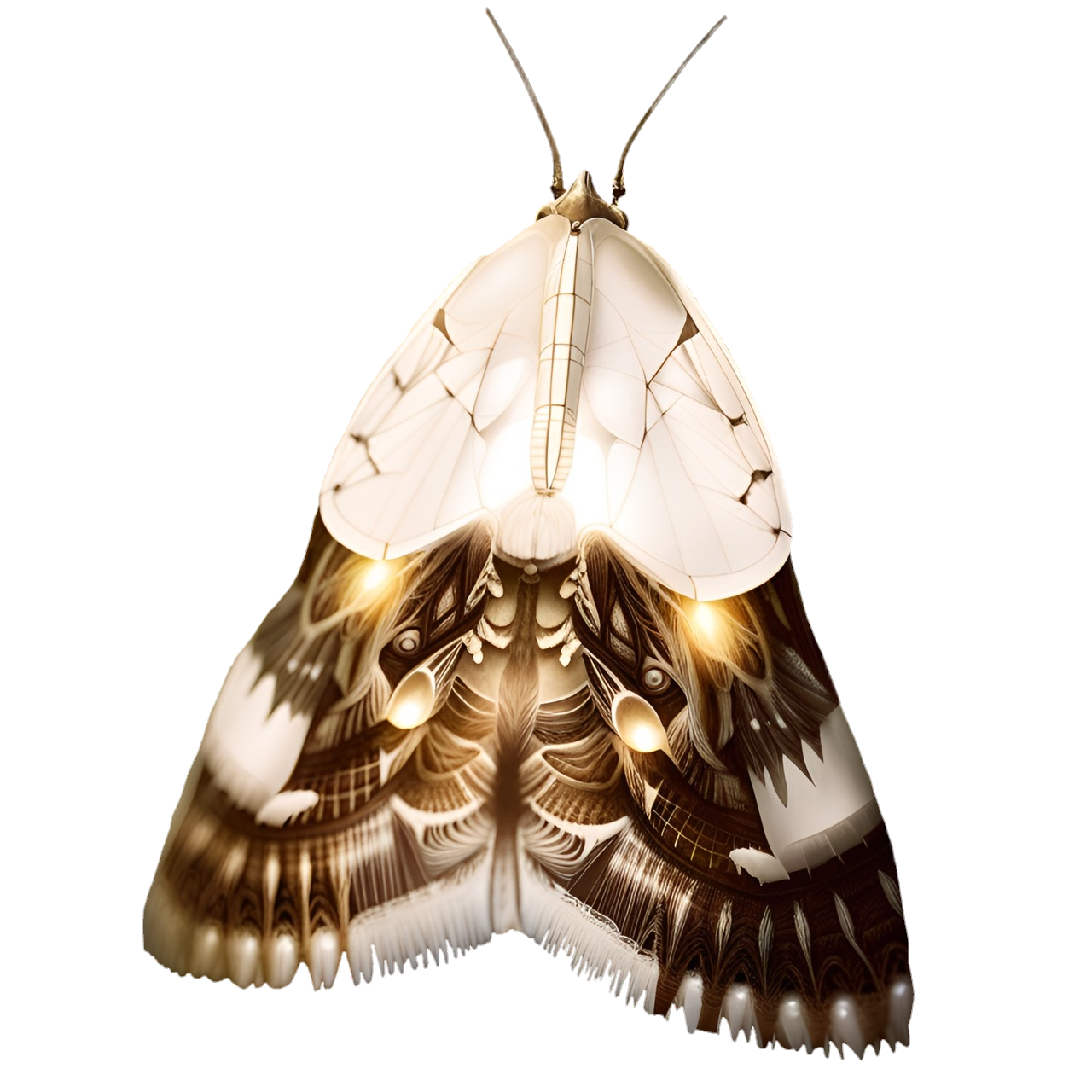
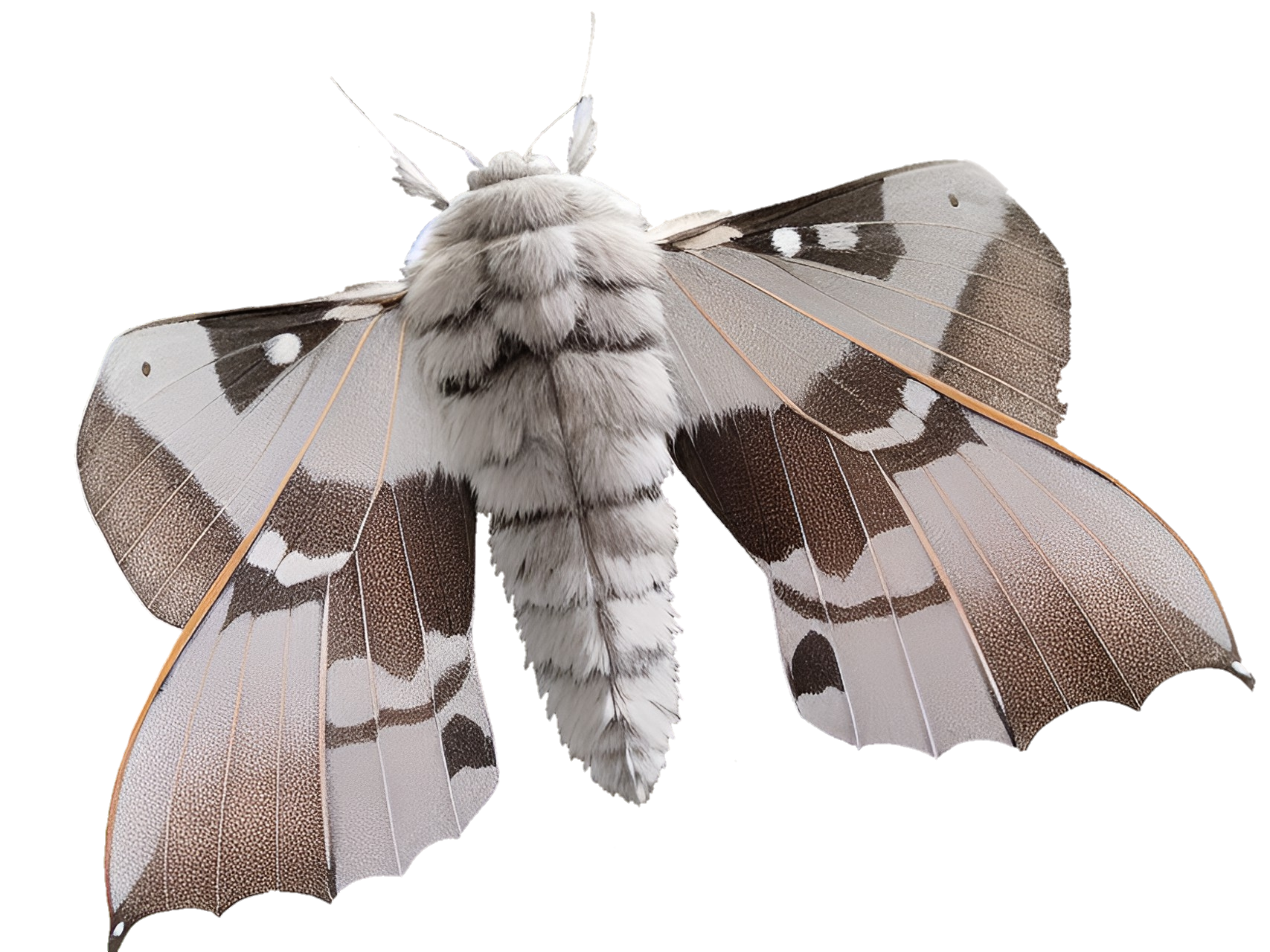
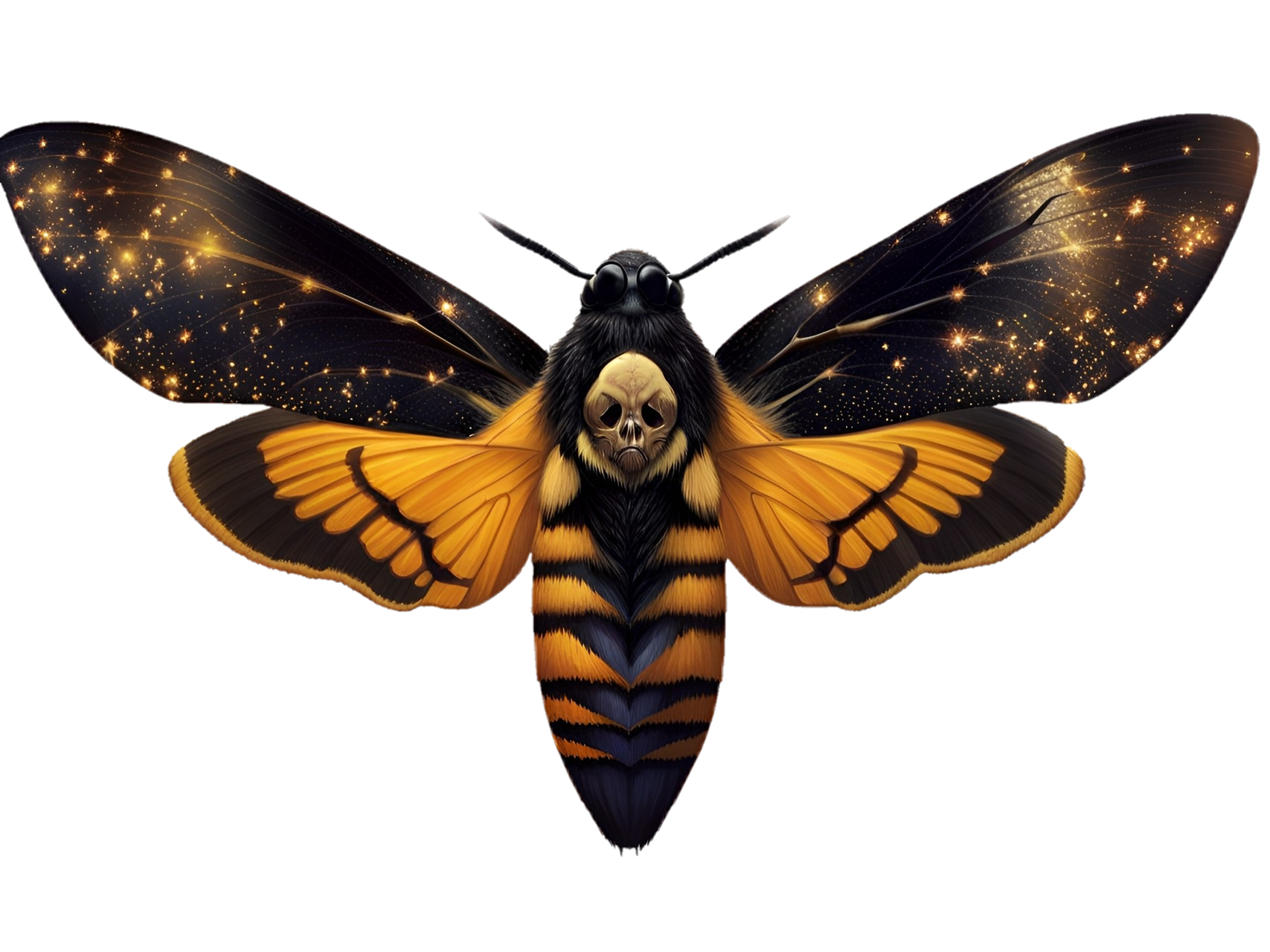
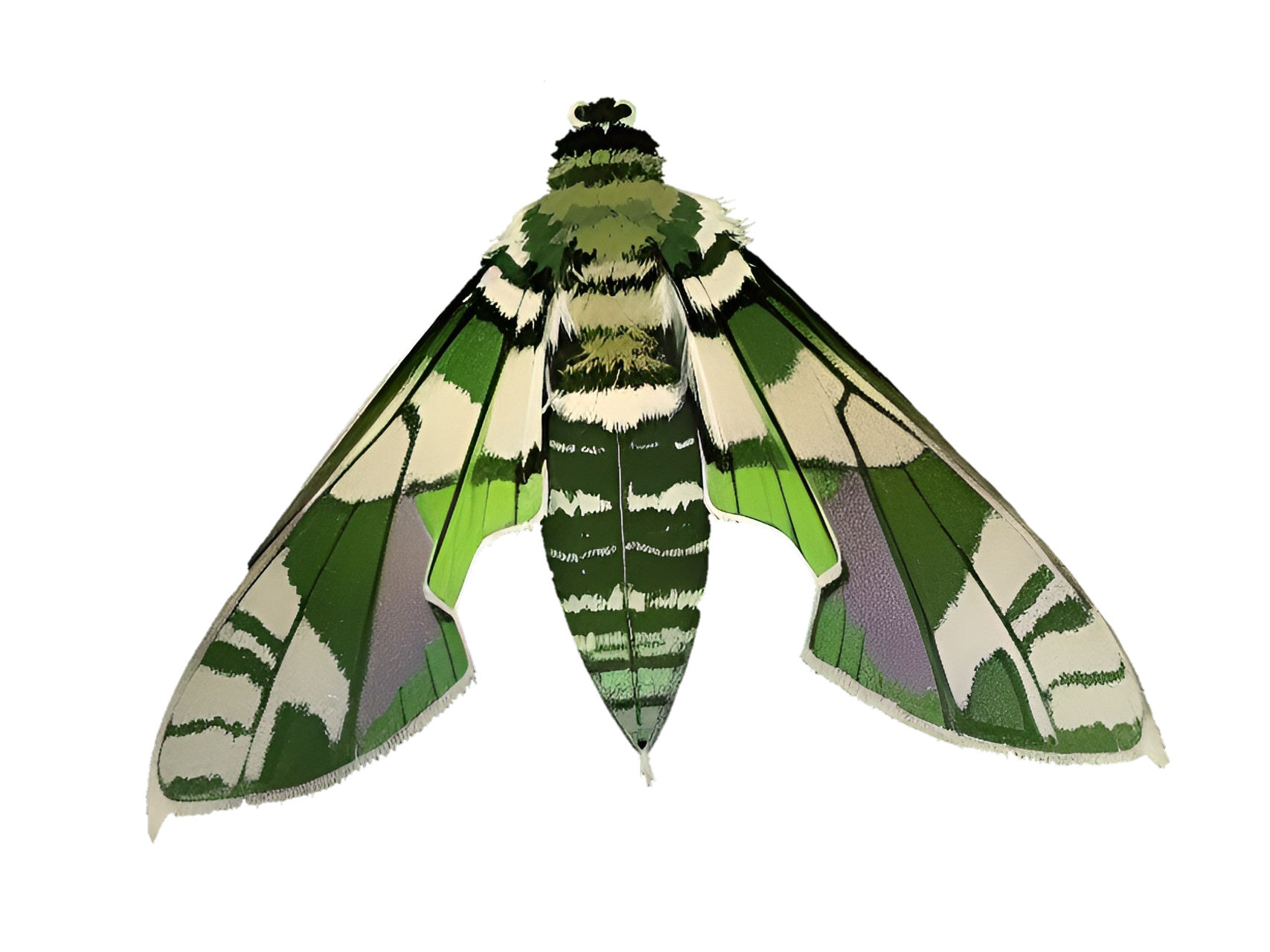


So floofy! I bet they're beautiful to see in the desert.
Yes! Bright little floofs fluttering through the desert, brilliant but searing hot! AI doesn't do bugs well so I have to leave it to the imagination.